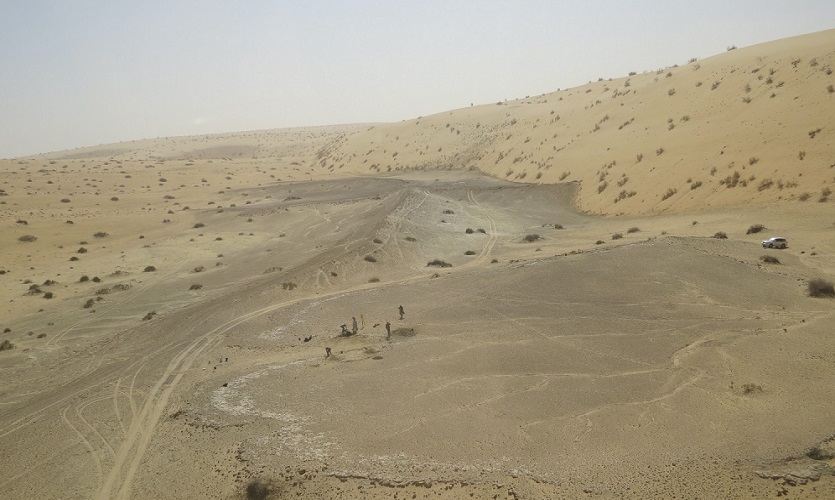Climate change ‘opened and closed’ migratory door through Arabia for 400,000 years

One of the driest places on Earth has intermittently been a 'green corridor' for human migration due to historical periods of increased rainfall, according to a research team.
New research published in Nature (September 1, 2021) shows that eras of increased rainfall have transformed the arid Arabian Peninsula into a crossroads for humanity over more than 400,000 years.
An international team of archaeologists, in partnership with the Saudi Ministry of Heritage, explored the northern Nefud Desert and found evidence of human activity associated with ancient lakes and grassland with animals such as elephants and hippopotamus.
During each ‘Green Arabia’ phase, early humans spread into the region, each bringing a different kind of material culture and establishing a crossroads between Africa, the Eastern Mediterranean and the Gulf.
Stone tools
The team found thousands of stone tools, revealing changing human culture over time. At the site of Khall Amayshan 4 – equidistant from Medina and Qurayyat - they found evidence for six phases of lake formation, five of them associated with stone tools made by early humans at around 400, 300, 200, 100, and 55 thousand years ago, nestled together in a hollow between large dunes.
Excavations at the Jubbah Oasis, 150 km to the east also recovered stone tools, dating to 200,000 and 75,000 years ago, while climate modelling confirmed the fluctuations in humidity and access to water in the region.
The new findings, including the first evidence for humans in Arabia at 400,000 years ago, are described as a “breakthrough in Arabian history” by Dr Huw Groucutt, lead author at the Max Planck Institute for the Science of Human History.
Dr Richard Jennings, Senior Lecturer in Archaeology at Liverpool John Moores University: “Our data indicates that it was more humid at certain times, with summer monsoonal rains moving from south to north over Arabia. The models confirm what we were finding on the ground - ancient dried up interdunal lake deposits and prehistoric artefacts.
“The discovery of stone tools from multiple periods of prehistory is clear evidence that our ancestors were inhabiting and passing through northern Arabia on multiple occasions.
Green Arabia
The dating of the archaeological sites – achieved through luminescence dating, which records the length of time since tiny grains of sediment were last exposed to sunlight – shows that each occupation dates to a time known to have had increased rainfall in the region.
This is also reflected by the fact that all of the stone tool assemblages are associated with the distinctive sediments produced by freshwater lakes.
Dr Groucutt said: “The findings show that within a dominant pattern of aridity, there were occasional short phases of increased rainfall in Arabia. This led to the formation of thousands of lakes, wetlands, and rivers that crossed most of Arabia, forming key migration routes for humans and animals.
“While today the Nefud desert is a very arid region, deep hollows between the large sand dunes created places for small lakes to form when rainfall occasionally increased. As a result, the Nefud region was periodically into a lush grassland that provided opportunities for repeated population movements.
Wider implications
Unlike bones and other organic materials, stone tools preserve very easily, and their character is largely influenced by learned cultural behaviours. As a result, they illuminate the background of their makers, and show how cultures developed along their own unique trajectories in different areas. The Khall Amayshan 4 and Jubbah Oasis findings reflect short-lived pulses of occupation that represent the initial phases of migration waves.
Added Dr Groucutt: “Each phase of human occupation in northern Arabia shows a distinct kind of material culture, suggesting that populations arrived in the area from multiple directions and source areas. This diversity sheds unique light on the extent of cultural differences in Southwest Asia during this timeframe, and indicates strongly sub-divided populations and in some cases the differences in material culture are so great as to indicate the contemporary presence of different hominin species in the region.”
He adds that the populations likely came from Africa as well as different regions of Eurasia.
Profesor Michael Petraglia, from the Max Planck Institute for the Science of Human History, concludes: “This work puts Arabia on the global map for human prehistory. Early human populations could face dramatic ups and downs, and the fact that all of them except our own are extinct offers a warning for our uncertain future.
NB: Liverpool John Moores University currently runs the BSc Human Evolution and Behaviour.


